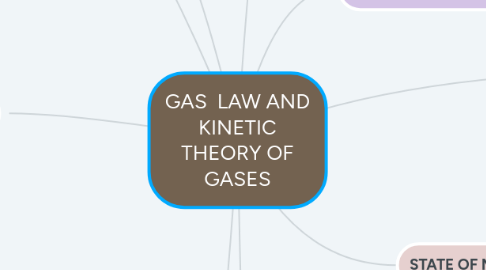
1. Gas particle is sensitively reacted to temperature, volume, pressure and number of mole changes.
2. CONCLUSION
2.1. Gas has a specific condition at standard temperature and pressure.
2.2. The speed of gas molecules can be determine using its kinetic theory of gases
2.3. Properties of gases can be identify using its mole concentration, density, molar mass.
3. KINETIC THEORY OF GASES
3.1. Characteristics of gas
3.1.1. Small molecules relatives to distance apart
3.1.2. Molecules in constant random motion
3.1.3. Ordered motion superimposed on random motion
3.1.4. Frequent collision between molecules
3.2. Kinetic theory for an ideal gas
3.2.1. Large number of molecules, N moving in random direction with a variety of speeds
3.2.2. The molecules are separated by great distances relative to their size
3.2.3. Collisions with another molecule are perfectly elastic, so no energy loss
3.2.4. There are no interaction between molecules, molecules obey laws of classical mechanics and interact only while colliding
3.3. Real gases
3.3.1. Characteristics/behaviour of gas where the pressure of gas is too high and the pressure of gas is too high and the temperature of gas close/near the boiling point, it is refer to behaviour of real gases
4. THE IDEAL GAS LAW
4.1. DEFINITION
4.1.1. The absolute pressure,P of an ideal gas is directly proportional to the kelvin temperature,T
4.1.2. The number of moles, n of the gas and is inversely proportional to the volume,V of the gas:P=R(nT/V)
4.2. FORMULA
4.2.1. PV=nRT (the temperature of T must be constant)
4.3. STANDARD CONDITION
4.3.1. Standard temperature and pressure(STP) 1 mol STP gas has the volume=22.4L
4.4. AVOGADRO’S NUMBER
4.4.1. STP: T=273K (0 degree Celsius)/1.00 atm=1.013x10^5 N/m^2=101.3kPa
4.4.2. 6.02X10^23 K is Boltzmann’s constant. PV=NkT K=1.38X10^-23 J/K
5. Molecule gas- no. of molecules= no. of mole, n times avogadro no.
6. INTRODUCTION
6.1. Basic SI unit amount of substance
6.2. 1g mole=molecular mass of substance
6.3. Mass=(1u)(atomic mass)
7. ATOMIC THEORY OF MATTER
7.1. Brownian motion is jittery motion of tiny flecks in water.
7.2. Measured in unified atomic mass units
8. GAS LAWS (absolute zero) = −273.15℃=0𝐾)
8.1. Charles' law
8.1.1. “The volume of a given amount of gas is directly proportional to absolute temperature(K)when the pressure is kept constant” V∝𝑇, when P is constant
8.1.1.1. V1/T1=V2/T2 The greater the temperature exerted on a gas, the greater its volume
8.2. Boyle's law
8.2.1. “at constant temperature, the pressure(P) in inversely proportional to the volume of the gas(V)” 𝑉∝ 1/p, when T is constant
8.2.1.1. PiVi=PfVf The greater the pressure exerted on a gas, the less its volume.
8.3. Pressure law/ Gay-Lussac's law
8.3.1. “The absolute pressure of a given amount of gas is directly proportional to the absolute temperature(K) when the volume is kept constant” 𝑃∝𝑇, when V is constant
8.3.1.1. P1/T1=P2/T2 The greater the temperature exerted on a gas, the greater its pressure
